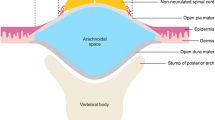Abstract
Two hundred and eight patients with meningomyeloceles were reviewed to assess the role of birth trauma in the pathogenesis of their neurological deficit. Vaginal breech-delivered patients appeared to have poorer neurological function in the newborn period. The factors responsible include: (1) a mid or upper lumbar level, that by sparing hip flexors and knee extensors, predisposes to breech presentation; (2) limb posturing due to residual neurological function and intrauterine positioning that limits the accurate neurological assessment of the newborn; (3) nervous system or soft tissue injury due to labor and delivery. Regardless of the mechanism, vaginal breech-delivered patients showed improvement in function, and eventually exhibited ambulatory function comparable to those infants born by cesarian section or vaginally after vertex presentation and labor. In our patient population, elective cesarian section did not offer a spinal cord or ambulatory advantage over vaginal delivery for those pregnancies presenting in a vertex fashion. Thus, it should be reserved for fetuses who are presenting breech or who have other obstetrical indications for operative delivery.
Similar content being viewed by others
References
Agamanolis DP, Hite SH, Platt MS, Boeckman CR (1986) Arnold-Chiari malformation. Report of four cases with contamination of the central nervous system by amniotic contents. Surg Neurol 25:261–266
Becroft DM, Gunn TR (1989) Prenatal cranial hemorrhages in 47 Pacific Islander in infants: is traditional massage the cause? N Z Med J 102:207–210
Bensen JT, Dillard RC, Burton BK (1988) Open spina bifida: does cesarian section delivery improve prognosis? Obstet Gynecol 71:532–534
Caldeyro-Barcia R, Poseiro JJ (1960) Physiology of uterine contraction. Clin Obstet Gynecol 3:386–408
Campbell S (1977) Early diagnosis of neural tube defects by ultrasound. Clin Obstet Gynecol 20:351–359
Chervenak FA, Duncan L, Ment LR, Tortora M, McClure M, Hobbins JC (1984) Perinatal management of meningomyelocoele. Obstet Gynecol 63:376–380
Cochrane DD, Myles ST, Nimrod C, Still RG, Sugarman RG, Wittmann BK (1985) Intrauterine hydrocephalus and ventriculomegaly: associated abnormalities and fetal outcome. Can J Neurol Sci 12:51–59
Hadi HA, Loy RA, Long EM Jr, Martin SA, Devoe LD (1987) Outcome of fetal meningomyelocele after vaginal delivery. J Reprod Med 32:597–600
Heffez DS, Aryanpur J, Hutchins GM, Freeman JM (1990) The paralysis associated with myelomeningocele: clinical and experimental data implicating a preventable spinal cord injury. Neurosurgery 26:987–992
Lindgren L (1977) The concept of pressure in biology and pressure transducers. Acta Obstet Gynecol Scand [Suppl] 66:87–123
Ralis ZA (1974) The role of mechanical intrauterine pressure in the pathogenesis of paralytic limb deformities. J Bone Joint Surg [Br] 56:383
Ralis ZA (1975) Traumatizing effect of breech delivery on infants with spina bifida. J Pediatr 87:613–616
Sakala EP, Andree I (1990) Optimal route of delivery for meningomyelocele. Obstet Gynecol Surv 45:209–212
Schurtleff DB, Luthy DA, Benedetti TJ, Hickok DE, Stuntz T, Kropp RJ (1987) The outcome of pregnancies diagnosed as having a fetus with meningomyelocele. Z Kinderchir 42 [Suppl I]:50–52
Schwarcz RL, Strada-Sáenz G, Althabe O, Fernández-Funes J, Alvarez LO, Caldeyro-Barcia R (1970) Compression received by the head of the human fetus during labor. In: Angle CR, Bering EA (eds) Physical trauma as an etiological agent in mental retardation. National Institute of Neurological Diseases and Stroke, US Government Printing Office, Washington, DC, pp 134–142
Stark G (1972) The nature and cause of paraplegia in meningomyelocele. Paraplegia 9:219–223
Stark G, Drummond M (1970) Spina bifida as an obstetrical problem. Dev Med Child Neurol 12 [Suppl 12]:157–160
Wallenburg HCS (1983) Human labour. In: Boyd R, Bottaglia FC (eds) Perinatal medicine. Butterworth London, pp 1–22
Author information
Authors and Affiliations
Rights and permissions
About this article
Cite this article
Cochrane, D., Aronyk, K., Sawatzky, B. et al. The effects of labor and delivery on spinal cord function and ambulation in patients with meningomyelocele. Child's Nerv Syst 7, 312–315 (1991). https://doi.org/10.1007/BF00304828
Received:
Issue Date:
DOI: https://doi.org/10.1007/BF00304828




